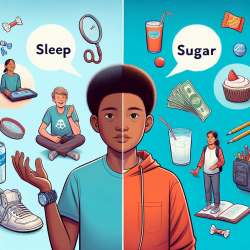Understanding the Connection: Sleep, Stress, and Type 2 Diabetes
Adolescence is a critical period for sleep health, with many adolescents failing to achieve the recommended 8-10 hours of sleep per night. This lack of sleep is linked to adverse health outcomes, such as obesity and type 2 diabetes (T2D). Notably, adolescents from historically minoritized racial and ethnic groups, such as Hispanic/Latinx and African American/Black, are at a greater risk for shorter sleep durations and subsequent health disparities, including T2D.
Key Findings from Recent Research
The research article "Racial and ethnic sleep health disparities in adolescents and risk for type 2 diabetes: a narrative review" highlights several critical points:
- Adolescents from minoritized groups face unique race-related stressors that impact sleep and increase T2D risk.
- These stressors can disrupt the body's stress response system, leading to sleep health disparities.
- There is a need for further investigation into the mechanisms underlying these disparities.
Practical Implications for Practitioners
As practitioners, understanding these connections can enhance our ability to support adolescents effectively. Here are some strategies to consider:
- Promote Sleep Hygiene: Educate adolescents and families on the importance of sleep routines and minimizing electronic device usage before bedtime.
- Address Race-Related Stress: Develop culturally sensitive interventions that address unique stressors faced by minoritized groups.
- Advocate for Policy Changes: Support policies that improve access to healthcare and educational resources for minoritized communities.
Encouraging Further Research
While current research provides valuable insights, there are still gaps that need addressing. Encouraging further research can help identify effective interventions and policies to mitigate these disparities. Consider collaborating with researchers or supporting studies that explore:
- The role of social determinants in sleep health disparities.
- Protective factors that can buffer the impact of race-related stressors.
- Effective prevention programs tailored to the needs of minoritized adolescents.
Conclusion
Understanding and addressing the connection between sleep, stress, and T2D is crucial for improving health outcomes among adolescents, especially those from minoritized groups. By implementing culturally sensitive interventions and supporting further research, practitioners can play a vital role in promoting sleep health equity and reducing T2D risk.
To read the original research paper, please follow this link: Racial and ethnic sleep health disparities in adolescents and risk for type 2 diabetes: a narrative review.










